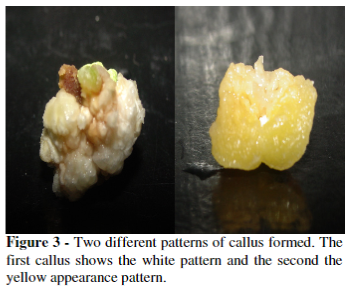In vitro protocol optimization for development of interspecific hybrids of oil palm (Elaeis oleifera (H.B.K) Cortés x Elaeis guineensis Jacq.)
DOI:
https://doi.org/10.20873/jbb.uft.cemaf.v2n3.alvesKeywords:
Actived charcoal, phenolic oxidation, embryo rescue, callogenesisAbstract
The oil palm (Elaeis guineensis) is the major source of plant oil in the world. Nevertheless, is susceptible to the fatal yellowing disease, which is affecting the oil palm production in Pará state, Brazil. To overcome this problem, interspecific hybrids of Elaeis oleifera x Elaeis guineensis is a viable alternative. Some protocols for in vitro embryo rescue were already established, but it is necessary to optimize it. The aim of this paper was to optimize the in vitro protocol for culture of embryos from interspecific hybrids of oil palm (E. oleifera x E. guineensis). Disinfection embryos were carried out with 1 and 2% NaOCl for 20 or 40 minutes. Embryos were germinated in vitro on the presence of 0, 0.1, 0.2 and 0.25% activated charcoal and Embryos were cultured in vitro on the presence of 2.4- Dichlorophenoxyacetic acid (2.4-D) at 375, 500 and 625 µM for callus induction. Activated charcoal (0.25%) is necessary to reduce oxidation in the embryos. Seed disinfection can be suitable reached with 1% NaOCl for 20 minutes. Different varieties have different ideal levels of 2.4-D for callus induction. The best level of 2.4-D for callus induction is 375 and 625 µM for the varieties SJ-167 and SJ-165, respectively.
References
Alves, S. A. O. Regaste de híbridos interespecíficos de dendezeiro (Elaeis oleifera x Elaeis guineensis). Dissertação de Mestrado da Universidade Federal Rural da Amazônia/Museu Paráense Emilio Goeldi, Belém, Pará. 2007.
Alves, S. A. O.; Lemos, O. F. de; Santos Filho, B. G.; Silva, A. L. L. da. (2011), In vitro embryo rescue of interspecific hybrids of oil palm (Elaeis oleifera x Elaeis guineensis). Journal of Biotechnology and Biodiversity, 2, 1-6.
Amblard, P.; Noiret, J. M.; Kouame, B.; Potier, F.; Adon, B. (1995), Performances compares des Hybrides interespecifics et du materiel commercial E. guineensis. Oleagineux, Crops Gras et Lipides, Montepellier, 2, 335-340.
Cattelan, L. V.; Stein, V. C.; Souza, S. A.; Heiden, G.; Buttow, M. V.; Bobrowski, V. L. (2007), Estabelecimento in vitro de Matricaria recutita utilizando diferentes condições de cultivo. Revista Brasileira de Biociências, 5, 201-203.
Cavalcante, A. S. L. Respostas morfogenéticas in vitro de açaizeiro (Euterpe oleracea L.) e de cupuçuazeiro (Theobrama grandiflorum (Wild. Ex Spreng) Schum). Tese de Doutorado da Universidade Federal do Ceará, 2001.
Cruz, C. D.; Regazzi, A. J. (2001), Modelos biométricos aplicados ao melhoramento genético. 2. ed. Viçosa: Universidade Federal de Viçosa, 390p.
Freitas, R. M. O. de; Oliveira, M. K. T. de; Dombroski, J. L. D.; Câmara, F. A. A. (2009), Efeito dos tratamentos de oxidação em Aloysia virgata. Revista Caatinga, 22, 151-154.
Hardon, J. J.; Tan, G. Y. (1969), Interespecific Hybrids in the Elaeis I. Crossability, cytogenetics and fertility of F1 Hybrids of E. guineensis x E. oleifera. Euphytica, 18, 372-379.
Murashige, T. and Skoog, F. (1962), Revised medium for rapid growth and bioassays with tobacco tissue culture. Physiologia Plantarum, 15, 473-497.
Nogueira, R. C.; Paiva, R.; Oliveira, L. M. S.; Araújo, G.; Soares, F. P.; Castro, A. H. F.; Paiva, P. D. O. (2007), Indução de calos em explantes foliares de murici-pequeno. Ciência e Agrotecnologia, 31, 366-370.
Obisesan, O. and Fatunla, T. (1983), Genotype X environment interaction for bunch yield and its components in the oil palm (Elaeis guineensis Jacq.). Theoretical and applied Genetics, 64, 133- 136.
Pereira, J. E. S.; Maciel, T. M. S.; Costa, F. H. S.; Pereira, M. A. A. (2006), Germinação in vitro de embriões zigóticos de murmuru (Astrocaryum ulei). Ciência e Agrotecnologia, 30, 251-256.
Pullman, G. S.; Gupta, P. K.; Timmis, R.; Carpenter, C.; Kreitinger, M.; Welty, E. (2005), Improved Norway spruce somatic embryo development through the use of abscisic acid combined with activated carbon. Plant Cell Reports, 24, 271- 279.
Rajesh, M. K.; Radha, E.; Karun, A.; Parthasarathy, V. A. (2003), Plant regeneration from embryo-derived callus of oil palm – the effect of exogenous polyamines. Plant Cell, Tissue and Organ Culture, 75, 41–47.
Santos, M. R. A.; Ferreira, M. G. R.; Correia, A. O.; Rocha, J. F. (2010), In vitro establishment and callogenesis in shoot tips of peach palm. Revista Caatinga, 23, 40-44.
Souza, R. S.; Carvalho, S. M. L.; Garcia Junior, M. R. L.; Sena, R. S. F. (2009), Adsorção de cromo (VI) por carvão ativado granular de soluções diluídas utilizando um sistema batelada sob pH controlado. Revista Acta Amazônica, 39, 661-668.
Teixeira, J. B.; Söndahl, M. R.; Kirby, E. G. (1993), Somatic embryogenesis from immature zygotic embryos of oil palm. Plant Cell Tissue and Organ Culture, 34, 227-233.
Viegas, I. de J. M.; Muller, A. A. (2000), A cultura do dendezeiro na Amazônia brasileira. Belém: Embrapa-Cpatu; Manaus: Embrapa-CPAA, 374p.

Published
How to Cite
Issue
Section
License
Copyright (c) 2024 - Journal of Biotechnology and Biodiversity

This work is licensed under a Creative Commons Attribution 4.0 International License.
Authors who publish with this journal agree to the following terms:
Authors retain copyright and grant the journal right of first publication with the work simultaneously licensed under a Creative Commons Attribution License (CC BY 4.0 at http://creativecommons.org/licenses/by/4.0/) that allows others to share the work with an acknowledgement of the work's authorship and initial publication in this journal.
Authors are able to enter into separate, additional contractual arrangements for the non-exclusive distribution of the journal's published version of the work (e.g., post it to an institutional repository or publish it in a book), with an acknowledgement of its initial publication in this journal.
Authors are permitted and encouraged to post their work online (e.g. in institutional repositories or on their website) prior to and during the submission process, as it can lead to productive exchanges, as well as earlier and greater citation of published work (Available at The Effect of Open Access, at http://opcit.eprints.org/oacitation-biblio.html).


